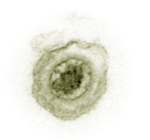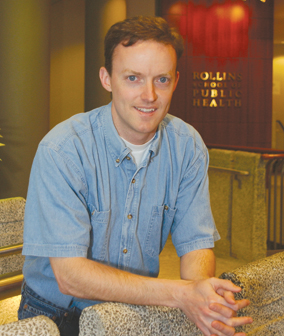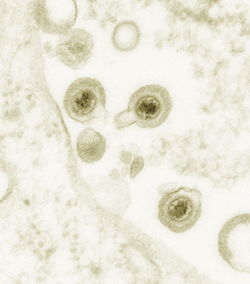The Human Strain Mike Cannon, 00PhD, is shedding light on a recently discovered strain of herpesvirus.
Cannon now works as a research epidemiologist in the Herpesvirus Section of the National Center for Infectious Disease at CDC. He also is an adjunct professor in the Department of Epidemiology at RSPH and thesis adviser for several MPH students. A native of Madison, Wisconsin, Cannon earned his undergraduate degree in math at Brigham Young University. He had never heard of epidemiology until he was a master’s degree student in Quantitative Ecology and Resource Management at the University of Washington. There, he became interested in mathematical biology and differential equations, which describe rates of change. “I was able to see how these equations can help us look at epidemics and see how they change over time and move through a geographic area,” he says. “Epidemiology is neat stuff, and it’s real—a perfect mix of a quantitative field with biology. And it was important to me to have a job that makes a difference in people’s lives rather than spending my career doing theoretical mathematics.” On the trail of HHV-8Cannon is making a difference, shedding light on a recently discovered strain of herpesvirus, human herpesvirus 8 (HHV-8), often found in people infected with HIV. He completed his dissertation on the epidemiology of HHV-8 and has since published several studies about the virus.
His dissertation helped establish that injection drug use was a risk factor for HHV-8 among drug-injecting women. Those who injected drugs more often and for longer periods of time were more likely to get infected. “There was a dose-response effect,” Cannon says. “This was exciting for me because it has implications for blood safety. It’s led to a number of studies investigating whether people can become infected with HHV-8 through blood transfusions. The viral DNA of HHV-8 can be found in saliva and blood, and less frequently in semen, so it’s possible to become infected without the sexual risk factors.” Cannon and his CDC colleagues are now studying blood specimens collected in the 1970s—before the advent of strict guidelines for blood donations—for signs of HHV-8 contamination. “If there is transmission through blood transfusion, we’re likely to find it in these collections,” he says. He also is involved in a study in Uganda, which has the highest incidence of Kaposi’s sarcoma in the world and where about half of the general population is infected with HHV-8. Because of the explosion of HIV in Africa, the findings of the study will be particularly significant. “It’s also important that we understand all the issues related to blood transfusion and HHV-8, because in places like Uganda, transfusions are essentially arm to arm.” Collaboration with the CDCAs a graduate student, Cannon began work on a continuing study to examine why some people with HHV-8 get cancer, and others don’t. In the study conducted with HIV-positive patients at Grady Memorial Hospital in Atlanta, those with HHV-8 virus circulating in their blood were found to be at high risk for Kaposi’s sarcoma. Those without circulating HHV-8 were at a lower risk. “Researchers who study HIV intuitively know that when the HIV viral load is high, patients experience more illness,” he says. “Similarly, if active HHV-8 viral replication and circulating virus in the blood is linked to cancer, we might be able to prevent the cancer if we treat HHV-8.” Cannon and colleagues are studying whether treatments can reduce the viral load in HHV-8 infected patients.  “There
are other ways to treat Kaposi’s sarcoma, such as chemotherapy and radiation. But the best way to prevent the cancer
is to treat HIV, because that reduces immunosuppression. We’re also looking at whether HHV-8 can be treated with
FDA-approved anti-viral treatments for other types of herpesviruses.”
The Grady study is a good example of how collaboration between Emory faculty and students and CDC staff pays off
for everyone. CDC and Emory faculty receive skilled, low-cost labor, and students gain unparalleled experiences.
“It was a fantastic opportunity to do some of everything,” Cannon says. “I designed the study, wrote the
protocol, got institutional review board (IRB) approval, enrolled the patients, hired people to interview them, and
analyzed the data. I learned real-world epidemiology and hopefully helped people with HHV-8 live healthier lives in
the process.”
By Valerie Gregg “There
are other ways to treat Kaposi’s sarcoma, such as chemotherapy and radiation. But the best way to prevent the cancer
is to treat HIV, because that reduces immunosuppression. We’re also looking at whether HHV-8 can be treated with
FDA-approved anti-viral treatments for other types of herpesviruses.”
The Grady study is a good example of how collaboration between Emory faculty and students and CDC staff pays off
for everyone. CDC and Emory faculty receive skilled, low-cost labor, and students gain unparalleled experiences.
“It was a fantastic opportunity to do some of everything,” Cannon says. “I designed the study, wrote the
protocol, got institutional review board (IRB) approval, enrolled the patients, hired people to interview them, and
analyzed the data. I learned real-world epidemiology and hopefully helped people with HHV-8 live healthier lives in
the process.”
By Valerie Gregg
Disease Detective | Instamatic Informatics | Veteran Epidemiologist | Expelling the Fiery Serpent Corps Class | Class Notes | Rollins School of Public Health
Copyright © Emory University, 2004. All Rights
Reserved. |


